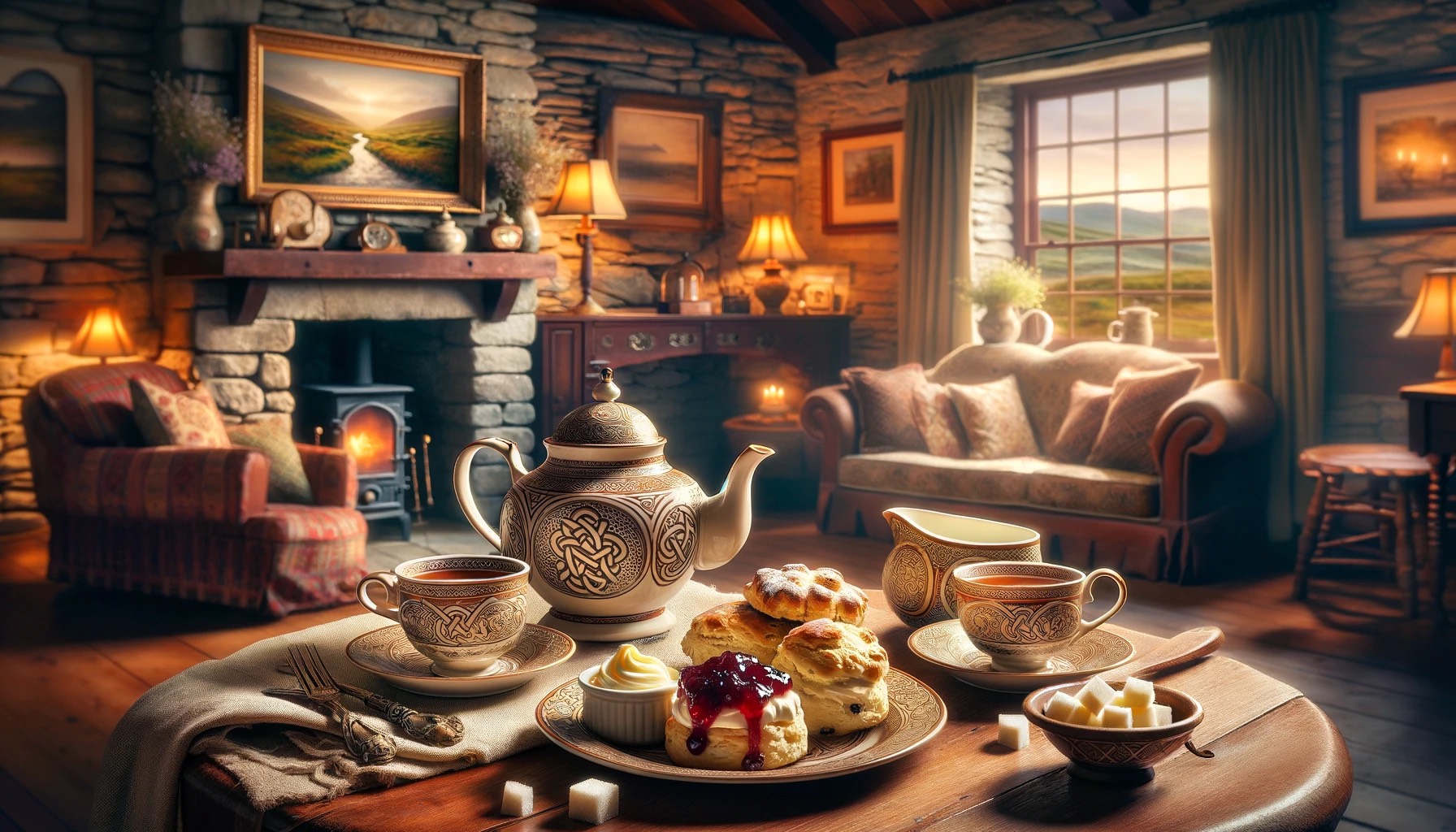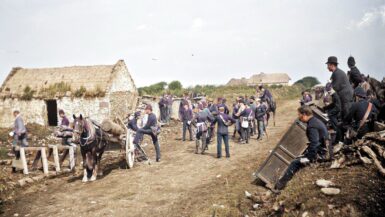In the emerald landscapes of Ireland, where the rhythm of life ebbs and flows with a distinct charm and warmth, tea isn’t just a beverage; it’s an emblem of comfort, a symbol of hospitality, and a cornerstone of daily life. The culture of tea in Ireland extends beyond the act of sipping this hot beverage. It’s interwoven into the social fabric, marking moments of joy, solace, and camaraderie. Irish tea culture, rich and steeped in tradition, tells the story of a nation’s resilience and its people’s unwavering love for the humble cuppa.
The quintessential Irish tea is robust, often a blend tailored to the soft water of the region, creating a unique taste that is both hearty and comforting. It’s more than just a morning wake-up call or an afternoon pick-me-up. In Ireland, tea is a ritual, an integral part of the day that brings people together, offering a pause for reflection and a chance for conversation. From family gatherings to a chat among friends, tea is the constant companion, ever-present in the ebb and flow of Irish life.
Contents
The Historical Brew: Tea’s Arrival in Ireland
The journey of tea to Ireland is as fascinating as the culture that embraced it. Tea first made its way to Ireland in the late 17th century, but it was not until the 18th century that it began to seep into the fabric of Irish society. Initially, tea was a luxury, savored by the aristocracy and the upper echelons of society. It was a symbol of status and wealth, a precious commodity that was enjoyed behind the closed doors of the affluent.
However, as the 19th century dawned, tea began to trickle down to the masses. The turning point in tea’s journey from an exclusive luxury to a household staple was a result of various factors. The reduction in the cost of tea, coupled with increased accessibility, played a significant role. By the mid-19th century, tea was being imported in large quantities, and its price had become more attainable for the average Irish family.
This democratization of tea marked a significant shift in Irish society. It became a beverage that transcended class boundaries, a unifier in a land marked by social and economic divides. The kettle and teapot, once symbols of privilege, became common household items, signifying a new era in Irish social life.
The Art of the Brew: Preparing Irish Tea
In the heart of Irish culture lies a deep appreciation for the art of brewing tea, a process that goes far beyond merely steeping leaves in hot water. The preparation of Irish tea is a ritual steeped in tradition, embodying a craftsmanship honed over generations. The secret to a perfect Irish brew lies in its strength, robustness, and the time-honored techniques used in its preparation.
The journey of a perfect cup of Irish tea begins with the selection of the tea itself. Typically, Irish tea blends are strong and brisk, often a mix of Assam and African teas, selected to complement the soft water prevalent in many parts of Ireland. This unique blend results in a tea that is rich, full-bodied, and capable of holding its flavor even when combined with milk.
Boiling water is the next critical step. Unlike the gentle warming favored in some cultures, Irish tea requires vigorously boiled water to fully extract the depth and strength of the leaves. The water’s temperature is crucial; it must be boiling to ensure the tea leaves release their full flavor and aroma.
Once the water reaches a rolling boil, it’s poured over the tea leaves or tea bags in a pre-warmed pot. This warming of the pot, a step often overlooked, is essential in maintaining the temperature throughout the brewing process. The tea is then allowed to steep, usually for several minutes, to achieve the desired strength. This steeping time is a matter of personal preference but is generally longer than in other tea traditions, resulting in a stronger brew.
Finally, the tea is served, often with a splash of milk and sometimes with sugar. The addition of milk is a distinctive feature of Irish tea, balancing the robust flavor of the brew. The result is a cup of tea that is not just a drink, but a comforting embrace, a moment of pause, a taste of Ireland.
The Irish Tea Time: More Than Just a Drink
Tea time in Ireland transcends the simple act of drinking tea. It is a cultural institution, a ritual that punctuates the day, providing rhythm and structure to daily life. Far more than a mere beverage break, Irish tea time is a moment for pause, connection, and hospitality.
In many Irish homes, the day is divided by tea times – the morning cuppa to start the day, the mid-morning tea break, the afternoon tea that bridges the gap between lunch and dinner, and the evening tea that often accompanies or replaces the nightcap. Each of these moments serves a purpose beyond quenching thirst or providing a caffeine boost. They are opportunities for interaction, for sharing news, for storytelling, and for community building.
Irish tea time, especially in rural areas, is synonymous with a warm welcome. A visitor is almost always greeted with an offer of tea, signaling hospitality and a willingness to share a moment of companionship. In a fast-paced world, these tea moments provide an opportunity to slow down, to savor both the tea and the company.
Moreover, Irish tea time often accompanies important life events, both big and small. From family gatherings to local meetings, from celebrations to wakes, tea is a constant companion, a symbol of normalcy and comfort in the midst of life’s changes.
The Perfect Pair: Tea and Irish Foods
The Irish tea experience is incomplete without mentioning the foods that traditionally accompany this beloved beverage. The pairing of tea with specific foods is an integral part of Irish tea culture, elevating the tea-drinking experience to a culinary event.
A classic Irish tea is often accompanied by scones, a type of lightly sweetened bread usually served with butter, jam, and sometimes cream. These baked goods are a staple in Irish tea culture, providing a simple yet satisfying complement to the tea. Scones can vary in flavor, from plain to those containing raisins or other dried fruits, offering a delightful contrast to the robustness of the tea.
Another traditional accompaniment is soda bread, a quick bread made using baking soda as a leavening agent instead of yeast. This dense, hearty bread is often served warm and is perfect for absorbing the flavors of the tea. It’s typically made with wheat flour, but variations include adding oats, seeds, or even treacle for a unique flavor.
In addition to these baked goods, afternoon tea in Ireland might include a range of sandwiches and cakes. Tea sandwiches are small, delicately prepared, and often include fillings like cucumber, smoked salmon, or egg salad. These light sandwiches offer a savory balance to the tea.
On the sweeter side, a range of cakes and pastries often accompany Irish tea. From the rich, dense fruitcake known as barmbrack to the lighter Victoria sponge cake filled with jam and cream, these sweets are a treat that complements the strong tea.
The Role of Tea in Irish Literature and Arts
Tea in Ireland extends beyond a mere culinary tradition; it has seeped into the realms of literature and arts, becoming a symbol rich in meaning and context. In Irish literature, tea often appears as a central theme or a subtle backdrop, symbolizing comfort, hospitality, and sometimes, social tension. From the works of James Joyce to contemporary Irish novelists, tea surfaces in narratives as a facilitator of conversation and introspection.
Irish poets have also brewed their thoughts with references to tea, using it as a metaphor for simplicity, warmth, and sometimes, the complexities of life. The act of sharing a cup of tea can denote friendship, a moment of solace, or a pause in a tumultuous narrative. In plays and prose, the preparation and serving of tea are often used to depict the dynamics of family life and the rituals that define Irish social interactions.
In the realm of visual arts, tea has been a subject and inspiration for many Irish artists. Paintings and sculptures sometimes feature tea-related elements, capturing the essence of Irish domestic life. These works often portray intimate settings, where the teapot and cups serve as focal points, symbolizing unity and a sense of belonging.
Moreover, in Irish music and folklore, tea surfaces in lyrics and tales, intertwining with the country’s rich oral tradition. Songs that mention tea often evoke nostalgia, harking back to simpler times, or serve as an allegory for Ireland’s social and cultural evolution.
Tea Houses and Cafés: The Social Hubs
The Irish tea culture is also embodied in the physical spaces where people gather to enjoy this beloved drink. Tea houses and cafés have long been social hubs in Ireland, each with its unique character and history. From the traditional tea rooms that hark back to the early 20th century to modern, eclectic cafés, these establishments are vital in the social tapestry of Ireland.
Classic Irish tea houses often exude a sense of timelessness, with their vintage décor and elegant tea sets. They serve as venues for social interaction, where people can enjoy a leisurely afternoon tea, complete with scones, sandwiches, and an array of cakes and pastries. These tea houses often maintain a traditional ambiance, offering a serene escape from the hustle and bustle of modern life.
In recent years, the café culture in Ireland has seen a renaissance, with a surge in establishments that blend traditional tea offerings with contemporary flair. These modern spaces often focus on providing a diverse range of teas from around the world, catering to the evolving tastes of the younger generation. They often double as venues for cultural events, like poetry readings or live music, aligning with the Irish penchant for storytelling and art.
Modern Trends: Ireland’s Evolving Tea Scene
While Ireland’s love for the traditional cup of strong, milky tea remains, there has been a noticeable shift in the tea scene, reflecting global trends and a growing awareness of health and sustainability. This evolution is evident in the increasing popularity of specialty teas, including green, white, and herbal infusions, which are gaining ground among health-conscious consumers.
The concept of tea sommeliers and artisanal tea blends has also taken root in Ireland. These experts curate unique tea experiences, combining traditional Irish preferences with exotic flavors and brewing techniques. This fusion approach has led to the creation of novel tea blends that honor the robustness of traditional Irish tea while introducing new flavor profiles.
Sustainability and ethical sourcing have become important considerations in the Irish tea market. Consumers are increasingly seeking out brands that offer organic, fair-trade teas, reflecting a global shift towards more ethically produced goods. This trend is not only changing purchasing habits but also influencing how tea is marketed and packaged.
Additionally, the Irish tea scene is experiencing a crossover with other beverages. Tea-infused cocktails and culinary creations that incorporate tea as an ingredient are becoming more popular, especially in urban centers. These innovative uses of tea in gastronomy and mixology are adding a contemporary twist to Ireland’s age-old tea culture.
Irish Tea in the Global Context
Ireland’s tea culture holds a distinctive place on the global stage. Known for being one of the highest per capita tea consumers in the world, Ireland’s relationship with tea is not just a matter of quantity but also of the unique character and tradition surrounding its tea consumption. This global recognition is a testament to how deeply embedded tea is in the Irish way of life.
Comparatively, Irish tea culture stands out for its preference for strong, robust blends, a contrast to the lighter teas favored in other high-consumption countries like China and Japan. The Irish penchant for adding milk to tea also sets it apart from many tea-drinking traditions worldwide. This practice, shared with the UK, is less common in Eastern tea cultures, where the focus is often on the purity and distinct flavors of the tea leaves themselves.
Internationally, Irish tea brands have gained recognition, with some becoming household names across the globe. These brands are celebrated not only for their quality but also for embodying the essence of Irish tea culture – strong, hearty, and comforting.
In the broader global tea culture, Ireland’s contribution is significant. The Irish approach to tea – making it a focal point for social gatherings, a symbol of hospitality, and a daily ritual – resonates with the communal aspect of tea-drinking found in many cultures, yet it has a distinctly Irish flavor.
Tea and Health: The Benefits of the Irish Cuppa
Tea, as a staple in the Irish diet, is not just a cultural icon but also a beverage with numerous health benefits. The traditional Irish black tea, consumed in moderate amounts, can contribute positively to overall health.
Rich in antioxidants, particularly flavonoids, regular consumption of black tea is associated with reduced risk of certain chronic diseases. These antioxidants help in neutralizing free radicals in the body, potentially reducing the risk of heart disease and certain types of cancer.
Tea also has a lower caffeine content compared to coffee, making it a suitable beverage for those who are sensitive to caffeine but still enjoy a gently stimulating drink. The presence of L-theanine, an amino acid unique to tea, is known to promote relaxation and help in stress reduction, complementing the comforting nature often associated with a hot cup of tea.
Moreover, tea is a hydrating beverage, contributing to daily fluid intake, and can be a healthy alternative to sugary drinks, assuming it is consumed without excessive sugar.
Preserving Tradition: The Future of Irish Tea Culture
As Ireland strides into the future, there is a conscious effort to preserve the rich tea culture that is an intrinsic part of its heritage. This preservation is not about resisting change but about maintaining the essence of the tradition while embracing modernity and innovation.
One key aspect of preserving this culture is through education and celebration. Tea festivals, tastings, and workshops are becoming more common, providing platforms for sharing knowledge about the history and nuances of Irish tea. These events serve to educate both locals and visitors about the cultural significance of tea in Ireland.
Incorporating tea culture into tourism is another way of preserving this tradition. Tea tours, visits to historic tea houses, and tea tasting sessions are becoming part of the Irish tourist experience, offering visitors a taste of authentic Irish culture.
At the same time, there is a growing recognition of the need to adapt to contemporary trends and environmental concerns. This includes embracing organic and sustainable tea farming practices, and the incorporation of global tea traditions into the Irish context, such as the increasing popularity of green and herbal teas.
In essence, the future of Irish tea culture lies in striking a balance between preservation and adaptation. By holding onto the rituals and values that define the Irish tea experience while remaining open to new influences and practices, Ireland can ensure that its tea culture remains vibrant and relevant for generations to come.






Leave a reply